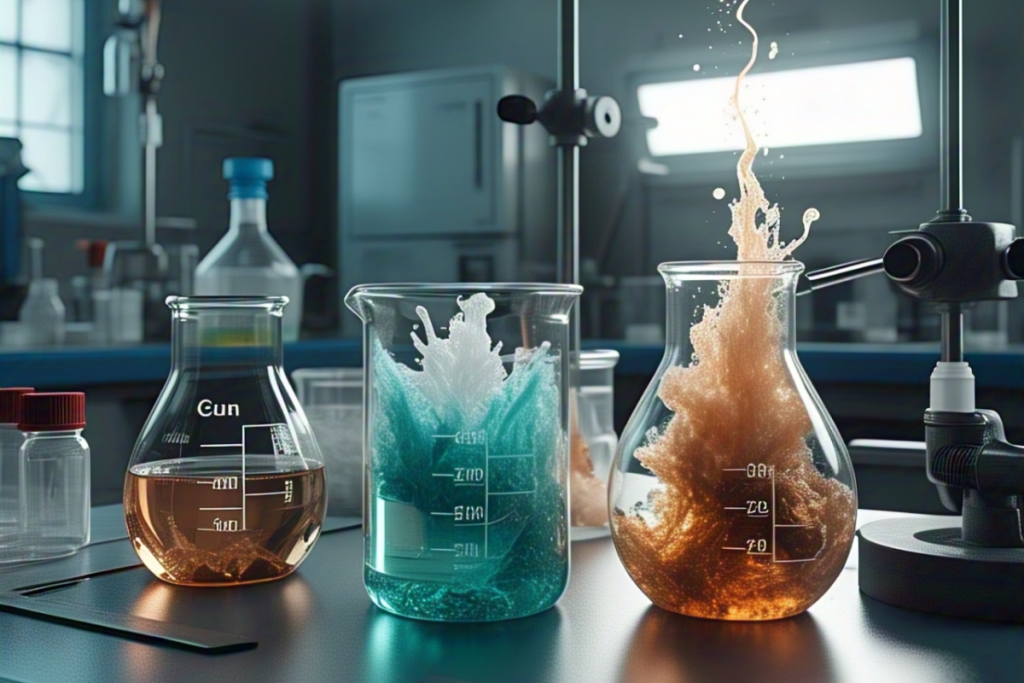reaction of metal with nitric acid equation
Introduction
When metals encounter nitric acid (HNO₃), something remarkable happens – a complex dance of electrons that produces distinctive compounds and gases. Unlike typical acid-metal reactions that produce hydrogen gas, nitric acid reactions follow their own unique path due to the powerful oxidizing nature of this acid. Let’s dive into the fascinating world of metal-nitric acid reactions and understand the equations behind these transformations.
Understanding Nitric Acid
Nitric acid (HNO₃) stands apart from other common acids like hydrochloric or sulfuric acid. As a powerful oxidizing agent, it doesn’t simply donate protons – it can also accept electrons, making its reactions with metals particularly interesting. This dual nature creates reaction pathways that chemistry students find both challenging and intriguing.
General Reaction Pattern
The general equation for metals reacting with nitric acid can be expressed as:
Metal + Nitric Acid → Metal Nitrate + Nitrogen Oxide(s) + Water
Unlike reactions with other acids where hydrogen gas is typically evolved, nitric acid oxidizes any hydrogen that might form, producing water and nitrogen oxides instead.
Concentration Matters: Dilute vs. Concentrated Nitric Acid
The concentration of nitric acid significantly affects the products formed:
Reactions with Dilute Nitric Acid
When metals react with dilute nitric acid, the products typically include metal nitrates, water, and nitric oxide (NO):

3Cu + 8HNO₃ (dilute) → 3Cu(NO₃)₂ + 2NO + 4H₂O
3Zn + 8HNO₃ (dilute) → 3Zn(NO₃)₂ + 2NO + 4H₂O
3Fe + 8HNO₃ (dilute) → 3Fe(NO₃)₂ + 2NO + 4H₂O
Reactions with Concentrated Nitric Acid
With concentrated nitric acid, nitrogen dioxide (NO₂) is more commonly produced:
Cu + 4HNO₃ (conc.) → Cu(NO₃)₂ + 2NO₂ + 2H₂O
Zn + 4HNO₃ (conc.) → Zn(NO₃)₂ + 2NO₂ + 2H₂O
Spotlight on Silver: A Classic Example
One of the most well-known reactions involves silver metal with nitric acid:
3Ag + 4HNO₃ → 3AgNO₃ + NO + 2H₂O
This balanced equation shows how three silver atoms react with four nitric acid molecules to produce silver nitrate, nitric oxide gas, and water. This reaction is particularly important in laboratory settings and silver processing.
Exceptions to the Rule
Interestingly, not all metals react the same way with nitric acid:
- Highly Reactive Metals: Magnesium and manganese can actually produce hydrogen gas when reacting with very dilute nitric acid: Mg + 2HNO₃ (very dilute) → Mg(NO₃)₂ + H₂
- Noble Metals: Gold and platinum are resistant to nitric acid alone (though they will dissolve in aqua regia, a mixture of nitric and hydrochloric acids).
Why No Hydrogen Gas?
A common question is why hydrogen gas isn’t typically produced when metals react with nitric acid. The answer lies in nitric acid’s strong oxidizing properties. Any hydrogen that might form is immediately oxidized to water, while the nitric acid itself is reduced to various nitrogen oxides depending on conditions.
Applications in Chemistry and Industry
These reactions have numerous practical applications:

- Purification of metals: Selective dissolution using nitric acid
- Etching and engraving: Especially for copper and silver
- Analytical chemistry: Identifying and separating metals
- Jewelry making: Cleaning and processing precious metals
Balancing These Complex Equations
Balancing metal-nitric acid equations can be challenging because they involve redox reactions where electrons are transferred. The half-reaction method is often the most effective approach, separating the oxidation of the metal from the reduction of nitric acid.
Safety Considerations
When working with nitric acid and metals, safety is paramount:
- Always work in a well-ventilated area due to toxic nitrogen oxide production
- Use appropriate personal protective equipment
- Add acid to water, never the reverse
- Be aware that some reactions can be extremely exothermic
Conclusion
The reaction of metals with nitric acid presents a fascinating window into redox chemistry. Unlike simple acid-metal reactions, these interactions showcase complex electron transfers that produce a variety of products depending on the specific metal and acid concentration. Understanding these equations not only helps in academic settings but has practical applications across numerous industries.
Whether you’re a chemistry student struggling with balancing these equations or a professional working with metal processing, appreciating the unique behavior of nitric acid with metals provides valuable insights into the world of chemical reactions.
Have you ever witnessed the distinctive reddish-brown fumes of nitrogen dioxide when metals react with concentrated nitric acid? Share your experiences in the comments below!







